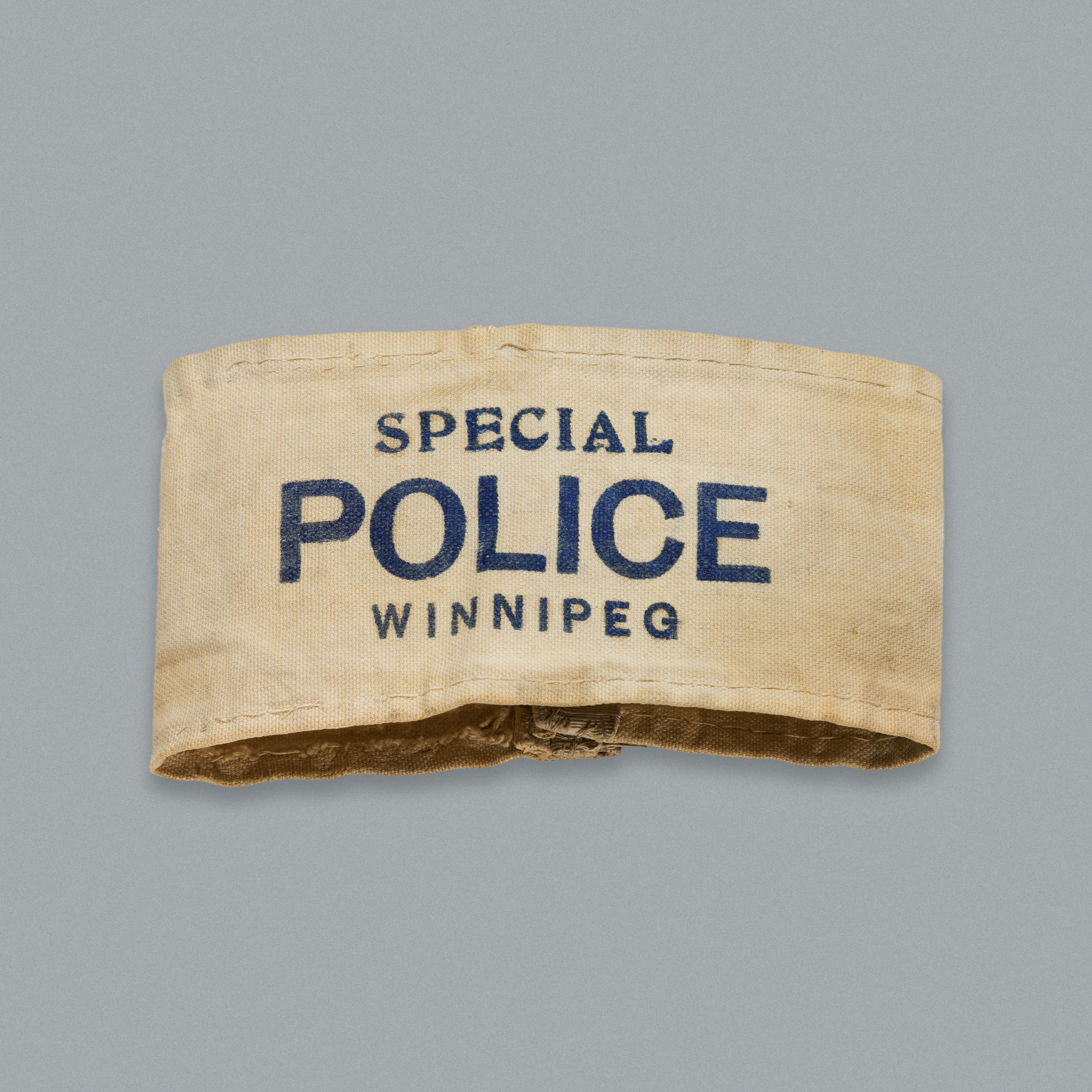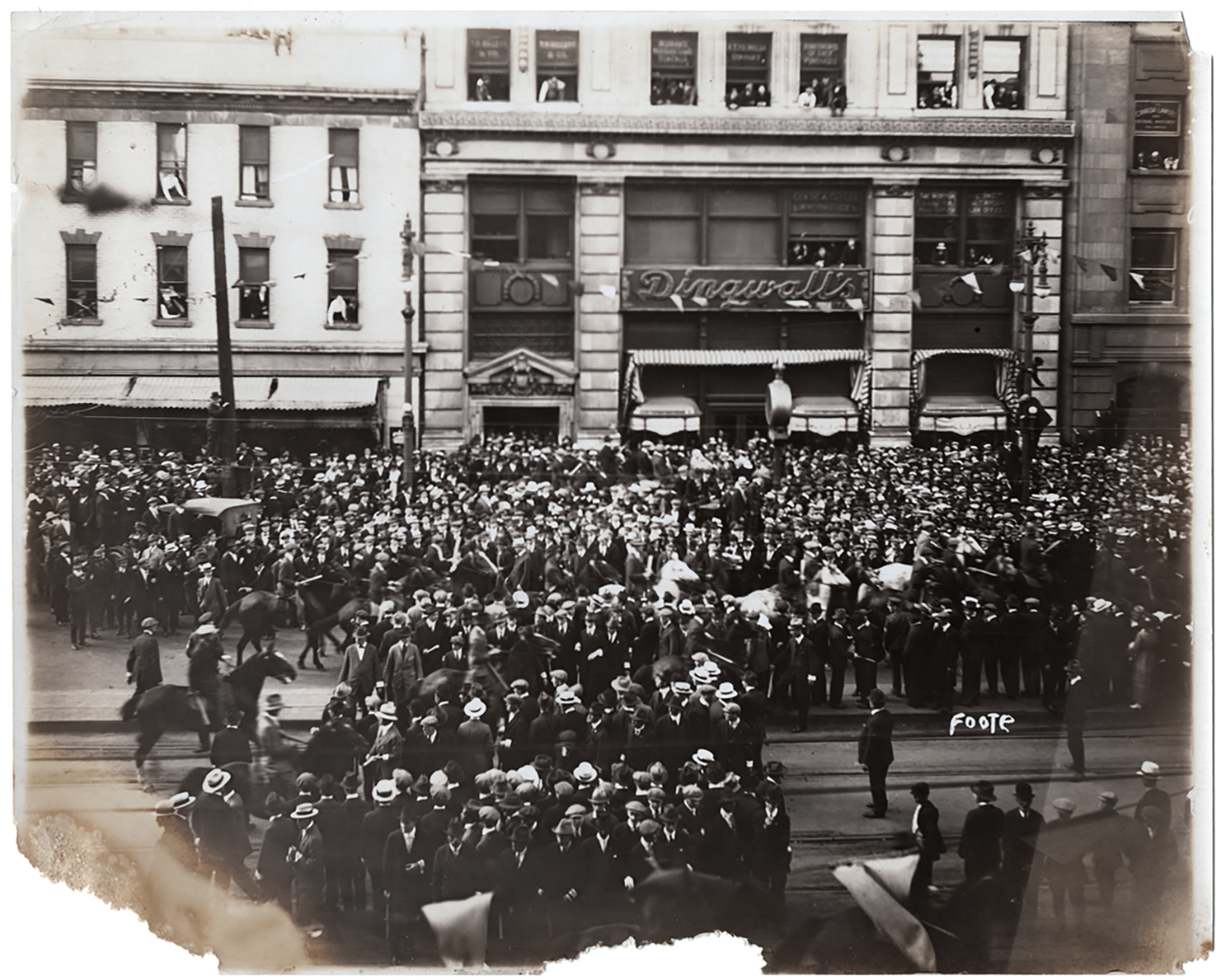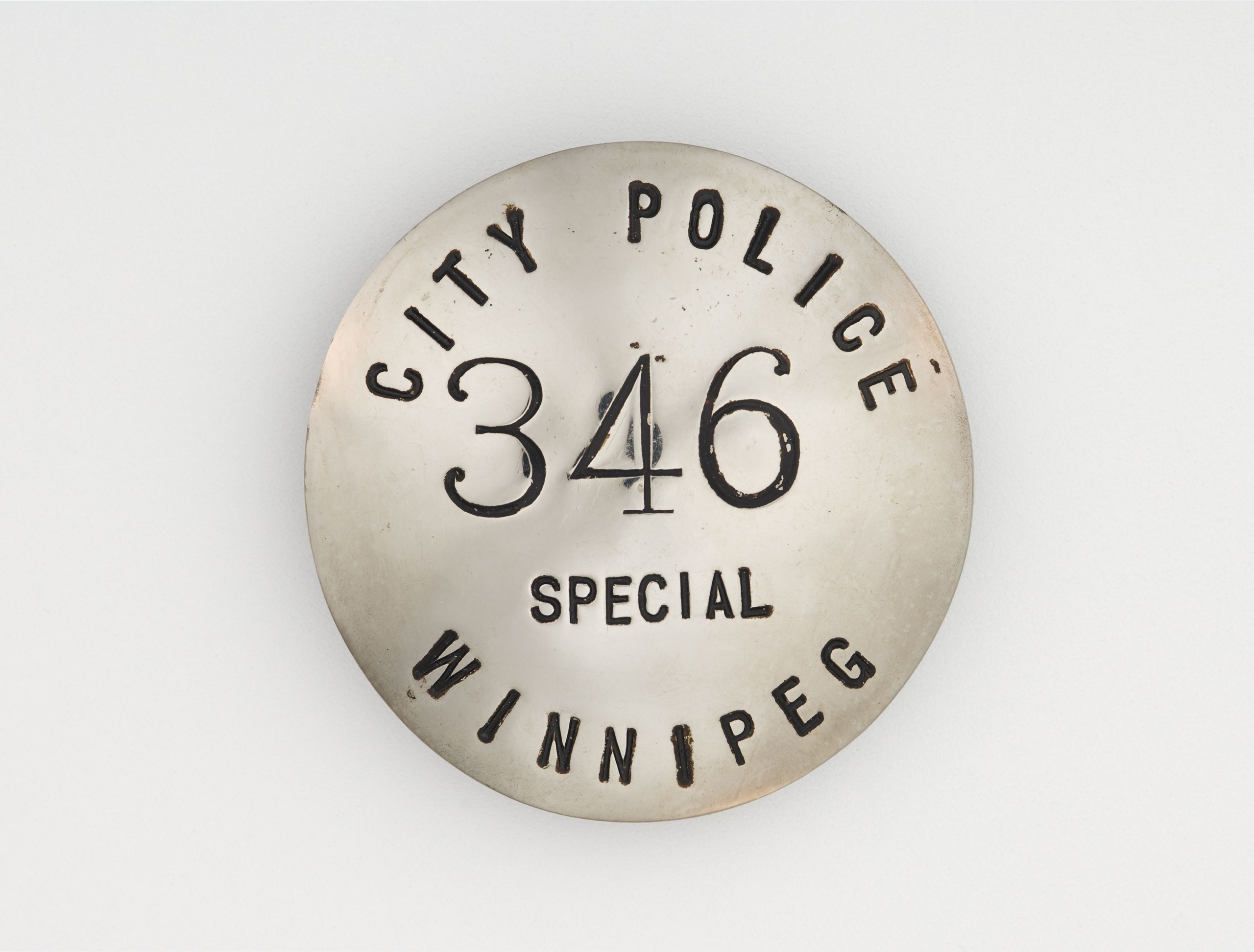Winnipeg Special Police Band
Artifact
Image
Video
Audio
 Activities
Activities
LOOK
Look closely at this object. What information does it tell you? What questions do you have about it? Read the Historical Context below to see if your questions are answered.
Details
 Materials
Materials - Cotton
- Metal
Historical Context
Choose one of the three levels below to match your needs.
- This is a police armband worn by “special constables” during the 1919 Winnipeg General Strike.
- In 1919, after the First World War, massive unemployment, inflation and poor working conditions led to 30,000 people walking off their jobs. Factories, shops, transit and city services shut down as a result.
- On June 21, 1919, six weeks after the strike began, a final mass demonstration was forcefully suppressed. Many were injured and arrested. People went back to work at 11 a.m. on June 26.
Scroll through the media carousel above to see a picture from the strike.
This is a police armband worn by “special constables” during the 1919 Winnipeg General Strike.
By spring 1919, after the First World War, massive unemployment, inflation and poor working conditions led to the Winnipeg General Strike, in which 30,000 people walked off their jobs. Factories, shops, transit and city services shut down as a result.
Governments and the business community reacted swiftly: 1,800 ordinary citizens, acting as special constables, replaced fired municipal police officers. On June 21, 1919, six weeks after the strike began, a final mass demonstration was forcefully suppressed. On what was known as Bloody Sunday, two people were confirmed dead, some 40 people were wounded and over 90 were arrested. The union called an end to the strike on June 25. People went back to work at 11 a.m. on June 26.
This is a police armband worn by “special constables” during the 1919 Winnipeg General Strike.
After the First World War, the return of thousands of troops to Canada, and the transition to a peacetime economy, led to great unrest, for which the country was ill-prepared.
By spring 1919, massive unemployment, inflation and poor working conditions led to the Winnipeg General Strike, when 30,000 people walked off their jobs. Factories, shops, transit and city services shut down as a result.
Governments and the business community reacted swiftly: 1,800 ordinary citizens, acting as special constables, replaced fired municipal police officers. The Royal North-West Mounted Police and the army intervened.
On June 21, 1919, six weeks after the strike began, a final mass demonstration was forcefully suppressed. On what was known as Bloody Sunday, two people were confirmed dead, some 40 were wounded, and more than 90 were arrested. The union called an end to the strike on June 25.
After being charged by horses and bayonets, hit by truncheon-wielding “goons” (as the special police officers were known) and shot by pistols, the strikers had had enough. People went back to work at 11 a.m. on June 26.
- This is a police armband worn by “special constables” during the 1919 Winnipeg General Strike.
- In 1919, after the First World War, massive unemployment, inflation and poor working conditions led to 30,000 people walking off their jobs. Factories, shops, transit and city services shut down as a result.
- On June 21, 1919, six weeks after the strike began, a final mass demonstration was forcefully suppressed. Many were injured and arrested. People went back to work at 11 a.m. on June 26.
Scroll through the media carousel above to see a picture from the strike.
This is a police armband worn by “special constables” during the 1919 Winnipeg General Strike.
By spring 1919, after the First World War, massive unemployment, inflation and poor working conditions led to the Winnipeg General Strike, in which 30,000 people walked off their jobs. Factories, shops, transit and city services shut down as a result.
Governments and the business community reacted swiftly: 1,800 ordinary citizens, acting as special constables, replaced fired municipal police officers. On June 21, 1919, six weeks after the strike began, a final mass demonstration was forcefully suppressed. On what was known as Bloody Sunday, two people were confirmed dead, some 40 people were wounded and over 90 were arrested. The union called an end to the strike on June 25. People went back to work at 11 a.m. on June 26.
This is a police armband worn by “special constables” during the 1919 Winnipeg General Strike.
After the First World War, the return of thousands of troops to Canada, and the transition to a peacetime economy, led to great unrest, for which the country was ill-prepared.
By spring 1919, massive unemployment, inflation and poor working conditions led to the Winnipeg General Strike, when 30,000 people walked off their jobs. Factories, shops, transit and city services shut down as a result.
Governments and the business community reacted swiftly: 1,800 ordinary citizens, acting as special constables, replaced fired municipal police officers. The Royal North-West Mounted Police and the army intervened.
On June 21, 1919, six weeks after the strike began, a final mass demonstration was forcefully suppressed. On what was known as Bloody Sunday, two people were confirmed dead, some 40 were wounded, and more than 90 were arrested. The union called an end to the strike on June 25.
After being charged by horses and bayonets, hit by truncheon-wielding “goons” (as the special police officers were known) and shot by pistols, the strikers had had enough. People went back to work at 11 a.m. on June 26.
Summary
- This is a police armband worn by “special constables” during the 1919 Winnipeg General Strike.
- In 1919, after the First World War, massive unemployment, inflation and poor working conditions led to 30,000 people walking off their jobs. Factories, shops, transit and city services shut down as a result.
- On June 21, 1919, six weeks after the strike began, a final mass demonstration was forcefully suppressed. Many were injured and arrested. People went back to work at 11 a.m. on June 26.
Scroll through the media carousel above to see a picture from the strike.
Essential
This is a police armband worn by “special constables” during the 1919 Winnipeg General Strike.
By spring 1919, after the First World War, massive unemployment, inflation and poor working conditions led to the Winnipeg General Strike, in which 30,000 people walked off their jobs. Factories, shops, transit and city services shut down as a result.
Governments and the business community reacted swiftly: 1,800 ordinary citizens, acting as special constables, replaced fired municipal police officers. On June 21, 1919, six weeks after the strike began, a final mass demonstration was forcefully suppressed. On what was known as Bloody Sunday, two people were confirmed dead, some 40 people were wounded and over 90 were arrested. The union called an end to the strike on June 25. People went back to work at 11 a.m. on June 26.
In-Depth
This is a police armband worn by “special constables” during the 1919 Winnipeg General Strike.
After the First World War, the return of thousands of troops to Canada, and the transition to a peacetime economy, led to great unrest, for which the country was ill-prepared.
By spring 1919, massive unemployment, inflation and poor working conditions led to the Winnipeg General Strike, when 30,000 people walked off their jobs. Factories, shops, transit and city services shut down as a result.
Governments and the business community reacted swiftly: 1,800 ordinary citizens, acting as special constables, replaced fired municipal police officers. The Royal North-West Mounted Police and the army intervened.
On June 21, 1919, six weeks after the strike began, a final mass demonstration was forcefully suppressed. On what was known as Bloody Sunday, two people were confirmed dead, some 40 were wounded, and more than 90 were arrested. The union called an end to the strike on June 25.
After being charged by horses and bayonets, hit by truncheon-wielding “goons” (as the special police officers were known) and shot by pistols, the strikers had had enough. People went back to work at 11 a.m. on June 26.



